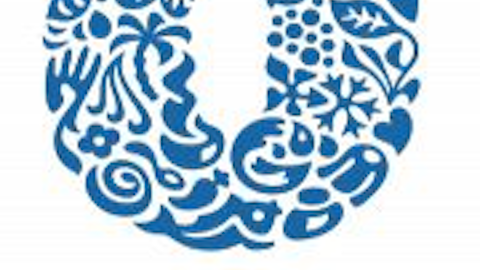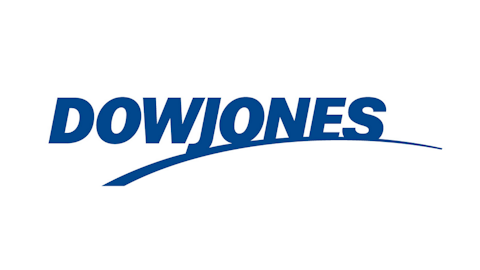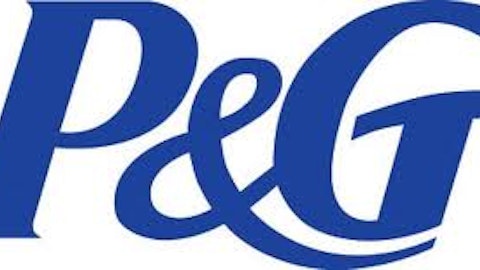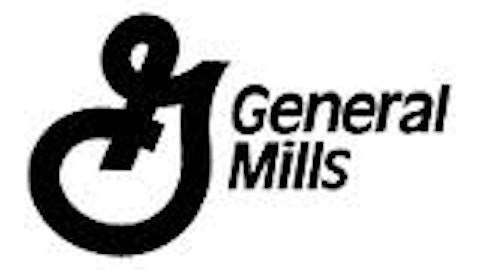The world’s largest consumer products company, with operations in more than 180 countries, The Procter & Gamble Company (NYSE:PG) has seen its shares rise 13.96% year to date, under-performing the Dow Jones Industrial Average by only 1.86% over that time span.
P&G’s core business is divided into two main segments, Beauty & Grooming and Household Care. The company’s brand portfolio includes 25 billion dollar brands, with 50 brands representing 90% of P&G’s sales. Based on market capitalization, the company is valued at $212.05 billion. Fundamentally, the company’s profit margin is relatively strong, with a TTM profit margin of 15.61%.

Strengths:
Incredibly Strong Product Portfolio:
The Procter & Gamble Company (NYSE:PG) possesses one of the strongest product portfolios in the world, with 25 billion dollar brands; with this incredibly strong product portfolio comes a greater level of security and predictability for investor
Historic Revenue Growth:
In 2003, P&G reported revenue of $43.37 billion; in 2012, the company announced revenue of $83.68 billion, representing year over year annual growth of 7.58%, a strong trend that is highly anticipated to continue into the future with projections placing 2017 revenue at $103.80 billion. This growth has been a result of consistent product innovation and several major acquisitions.

Institutional Vote of Confidence:
58% of shares outstanding are held by institutional investors, representing over $120 billion in investment, displaying the confidence some of largest investors in the world have in the company and its future
Strong Cash Flow:
In 2012, the company generated $12.11 billion in cash flow, giving the company the financial strength to pay out its dividend, which yields 3.11%.
Margin Expansion:
Over the past decade, P&G’s quarterly profit margin has expanded from 12.50% to the current 18.30% level, an extremely advantageous trend of the company.

- Diversified & Established Business:
P&G sells a broad array of products in more than 180 countries, with more than $83 billion in revenue in 2012; with this diversified and established business comes a greater level of predictability and security for investors.

Relatively Low Volatility:
At the moment, the company carries a beta ratio of 0.46, representing a company trading with considerably less volatility than the overall market, a strength for long-term investors
.
Weaknesses:
- Net Debt:
The Procter & Gamble Company (NYSE:PG)’s $6.6 billion in cash and cash equivalents is outweighed by its $46 billion debt load, resulting in a net debt of roughly $39 billion, $14.37 per share, a minor financial weakness of the company.

Opportunities:
Dividend Growth:
Since implementing its dividend program in 1891, P&G has consistently raised their dividend payouts.

Market Share in Fabric Care:
The Procter & Gamble Company (NYSE:PG)’s market share of the global fabric care market (2008: 31.1%, currently: 30.4%) market share of the global surface, dish, and air care market (2008: 20.0%, currently 20.1%); any gain in market share could fuel growth and sales
.


Market Share in Beauty:
P&G’s market share of the global beauty market (2008: 15.4%, currently: 13.2%); any gain in market share could fuel growth and sales
.

- Market Share in Baby Care:
The Procter & Gamble Company (NYSE:PG)’s market share of the global baby diapers market (2008: 46.9%, currently: 43.5%) market share in the global tissue production market (2008: 16.8%, currently: 19.7%); any gain in market share could fuel growth and sales
.


- Market Share in Health Care:
P&G’s market share of the global health care product market (2008: 10.1%, currently: 10.0%); any gain in market share could fuel growth and sales.

Market Share in Grooming:
P&G’s market share of the global grooming market (2008: 46.2%, currently: 46.6%); any gain in market share could fuel growth and sales
.

- Growth in Fabric Care, Beauty, Baby Care, Health Care, and Grooming Markets:
All of these essential markets have grown considerably since 2008, fueled primarily by increasing prosperity in emerging markets such as Latin America and Asia, and with acceleration in all of these industries anticipated P&G is presented the opportunity to meet growing demand and fuel growth
.
Acquisitions:
The company possesses a long history of acquiring quality brand names from other companies and utilizing their established distribution network to increase sales of the product and fuel growth; further acquisitions could add to the company’s large portfolio of brands and increase revenue.- Brazil, Russia, India, and China:
Since 2002, Brazil has grown with a compound annual growth rate of 23%, Russia with a rate of 25%, India with a rate of 27%, and China with a rate of 17%; and with further growth in these core markets anticipated the company is presented the opportunity to fuel overall growth.

Threats:
Rising Material Prices:
Any rise in the price of the materials the company utilizes to manufacture its products could squeeze margins and threaten business.
Competitors:
Major publicly traded competitors of P&G include Church & Dwight Co., Inc. (NYSE:CHD), Colgate-Palmolive Company (NYSE:CL), The Clorox Company (NYSE:CLX), and Avon Products, Inc. (NYSE:AVP). All of these companies operate in the consumer staples industry and compete directly with Procter & Gamble.
Church & Dwight is valued at $8.33 billion, pays out a dividend yielding 1.86%, and carries a price to earnings ratio of 23.63. Church & Dwight offers a broad range of household, personal, and specialty products, with its most prominent brand being Arm & Hammer. Since 2006, the company’s TTM profit margin has been expanding, from the 6% level in 2006 to the current 12.01% mark.
Colgate is valued at $54.91 billion, pays out a dividend yielding 2.31%, and carries a price to earnings ratio of 24.04. Colgate operates in two major segments: oral, personal, & home care and pet nutrition. In April, the company completed a 17:25 stock split. The company’s business model is fundamentally strong, with a TTM profit margin of 13.60%.
Clorox is valued at $11.09 billion, pays out a dividend yielding 3.04%, and carries a price to earnings ratio of 19.73. Clorox’s core business operates in the it’s cleaning, household, lifestyle, and international segments. Fundamentally, the company’s business model is tested and stable, with a TTM profit margin of 10.02%.
Avon is valued at $10.05 billion, pays out a dividend yielding 1.03%, and carries a negative price to earnings ratio. Avon’s business is concentrated in the beauty products industry, with the company’s operations stretching through 64 countries. Fundamentally, Avon’s business model is flawed, with a TTM profit margin of -0.78%.
The Foolish Bottom Line
Financially, The Procter & Gamble Company (NYSE:PG) is extremely solid. The company possesses stable revenue growth, one of the strongest product portfolios in the world, and a growing dividend. Looking forward, the company is likely to derive fast-paced growth from emerging markets and innovative product offerings . All in all, Procter & Gamble is one of the strongest businesses in the world, however presently is vastly overvalued relative to the caliber of growth expected from the company in the upcoming set of years. Thus, investors should wait for a substantial pullback in the stock before adding this safe and stable company to their long-term portfolio.
Ryan Guenette has no position in any stocks mentioned. The Motley Fool recommends Procter & Gamble.
The article The World’s Largest Consumer Products Company originally appeared on Fool.com.
Copyright © 1995 – 2013 The Motley Fool, LLC. All rights reserved. The Motley Fool has a disclosure policy.




